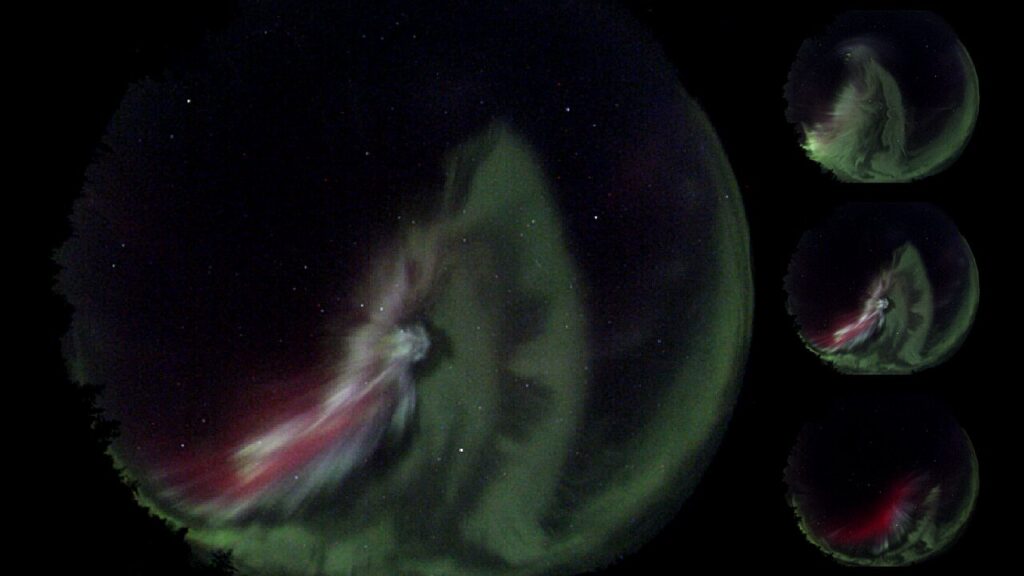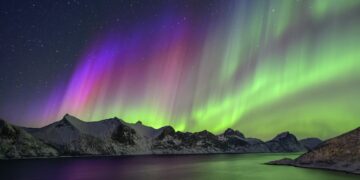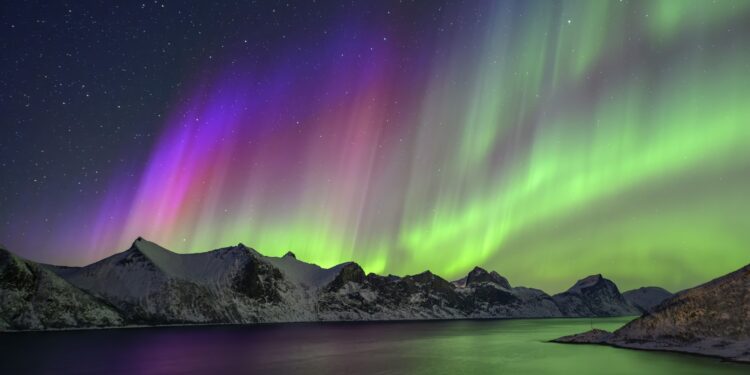The northern lights, or aurora borealis, have long enchanted observers with their colorful displays in the Arctic skies. But amidst these spectacular green and red hues, scientists recently uncovered a new phenomenon that deepens the mystery of this celestial spectacle: a ghostly white or gray patch that appears alongside the vibrant auroras.
A Closer Look at the White Patch Phenomenon
The discovery of the white patch, termed “structured continuum emission,” has added a fresh layer to the science of auroras. Unlike the traditional bright green or red auroras caused by charged particles colliding with gas molecules in the upper atmosphere, this white patch appears as a faint, ethereal glow embedded within the auroral activity.

Dr. Emma Spanswick, the lead author of the study, described it as a “heat source” intertwined with the aurora borealis. While it has been referenced sporadically in scientific literature, this is the first time its origins have been systematically explored. What makes this phenomenon stand out is its subtle nature and the advanced technology required to detect it.
The Role of Technology in the Discovery
The breakthrough was made possible by advancements in digital imaging technology. Cameras now have the ability to capture true-color images of the night sky, revealing details that were previously invisible to the naked eye or older equipment. Dr. Spanswick explained, “Your smartphone can now take vivid pictures of the auroras, and that leap in technology has also benefited scientific imaging tools.”
These new tools allowed researchers to document the white patch in ways that earlier generations of scientists could only dream of.
How the White Patch Differs from Traditional Auroras
Traditional auroras are caused by solar particles colliding with oxygen and nitrogen molecules, resulting in characteristic green, red, and purple lights. In contrast, the structured continuum emission appears as a white or gray glow and has a thermal origin. This suggests a complex interaction of atmospheric energy that goes beyond the well-known mechanisms of auroras.
Interestingly, the white patch shares some similarities with another phenomenon called STEVE (Strong Thermal Emission Velocity Enhancement). STEVE is a mauve or gray ribbon of light that forms independently of auroras, and while the two phenomena differ in structure and location, they both hint at previously uncharted atmospheric processes.
What the White Patch Tells Us About the Atmosphere
The white patch phenomenon serves as a reminder of the complexity of Earth’s atmosphere. It reveals that auroral activity is not solely about visible light but also involves intricate energy exchanges. These insights have significant implications for understanding atmospheric dynamics, space weather, and even how these phenomena might influence satellite operations.
The structured continuum emission also underscores the role of heat and energy transfer in shaping atmospheric phenomena.
The Connection to STEVE: Unveiling Similar Mysteries
STEVE, first observed in recent years, is another example of how the aurora borealis can surprise us. Like the white patch, STEVE is a distinct phenomenon that challenges traditional views of auroras. It appears as a long, ribbon-like band, separated from traditional auroras, and has become a topic of intense study.
Dr. Spanswick noted that while STEVE and the white patch share some spectral similarities, they are fundamentally different in terms of structure and behavior. However, the discovery of these phenomena highlights the vast amount of atmospheric knowledge yet to be uncovered.
Microlensing and the Role of Light
One of the most fascinating aspects of the study was the role of microlensing—a phenomenon often associated with astrophysical observations of distant galaxies. In this context, microlensing occurs when small objects in the atmosphere, such as free-floating particles, amplify light from the auroras. This magnification effect provided scientists with a clearer view of the white patch, allowing for detailed study.
This double-layered lensing effect is a testament to the interconnectedness of physical phenomena, from the microscopic to the cosmic scale.
Why This Discovery Matters
The identification of the structured continuum emission is more than just a scientific curiosity—it has real-world implications. Understanding the mechanisms behind this phenomenon can enhance our ability to predict and mitigate space weather effects on technology, including satellites and communication systems. Additionally, it deepens our appreciation of the complexity of Earth’s atmospheric processes.
For the public, this discovery adds another layer of wonder to the northern lights. The idea that there are still hidden secrets within such a familiar phenomenon is both humbling and inspiring. It reminds us of the vastness of nature’s mysteries and the potential for future discoveries.
The Educational Impact of the Study
This research also highlights the importance of fostering curiosity and collaboration in scientific endeavors. Undergraduate student Josh Houghton played a key role in analyzing the data, demonstrating how early-career scientists can contribute meaningfully to groundbreaking discoveries. His involvement underscores the value of mentorship and hands-on experience in shaping the next generation of researchers.
Dr. Spanswick praised Houghton’s contributions, noting that his work not only enriched the study but also provided him with a transformative learning experience. This collaboration serves as a model for how scientific research can inspire and educate simultaneously.
Conclusion: A New Light on the Northern Lights
As we continue to study the auroras, we are reminded that even familiar phenomena can hold secrets waiting to be uncovered. The structured continuum emission is not just a scientific breakthrough—it’s a celebration of the human spirit’s relentless pursuit of knowledge. So, the next time you gaze at the northern lights, remember that there’s more to the story than meets the eye.
Reference:



















